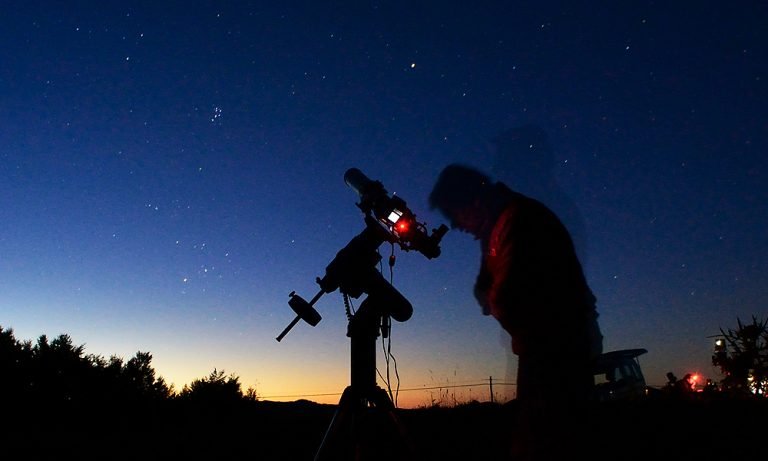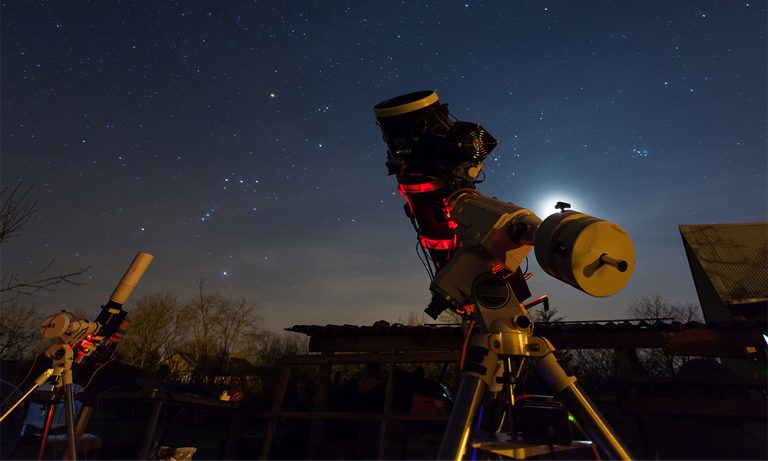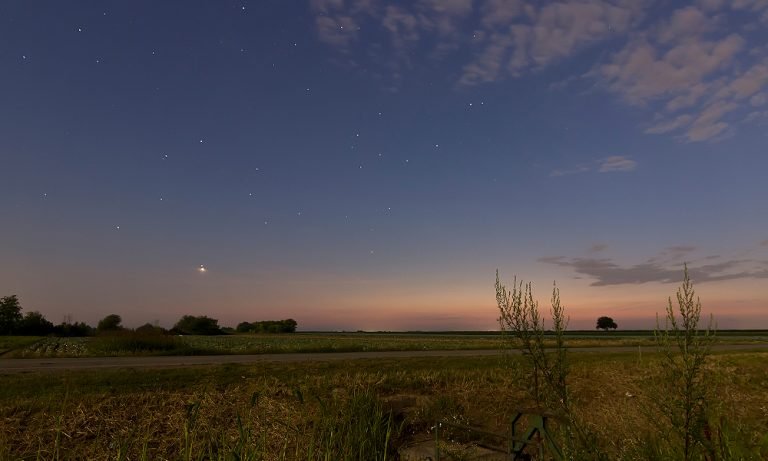10 Best Dobsonian Telescopes for Beginners (2024)
Dobsonian is the ideal first scope because it offers a lot of aperture for the money (the most important thing) and has a dummy-proof mount which is essential.
The consensus is that 8-inch is the best “size” telescope that hits that sweet spot between portability and aperture. If you are on a very tight budget, then go for a 6-inch.
The best Dobsonian telescope has a large aperture, is easy to use, and is reasonably portable.
Best Dobsonian Telescope
1. Orion SkyQuest XT8 Classic Reflector Dobsonian Telescope Kit
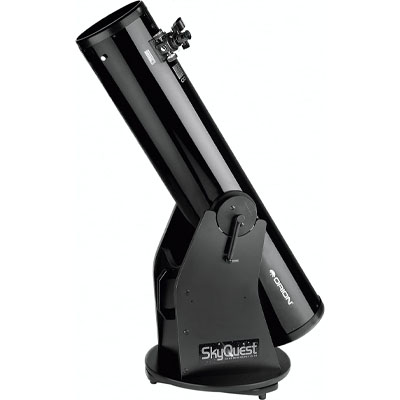
If you are wanting to upgrade from a beginner telescope to an 8 inch Dobsonian reflector that will last a lifetime, the Orion SkyQuest XT8 Dobsonian Reflector Telescope Kit is a great choice. My family always enjoys a Dobsonian scope with accessories. It gives you immediate versatility and you don’t need to buy extra bits and pieces.
For great looks, the Orion SkyQuest XT8 sports a stunning black optical tube. It has a new base with adjustable altitude tension knobs. The secondary mirror can be adjusted for collimation using the handy thumbscrew. You do not need any tools – a perk for people like me who are not great at DIY projects.
The telescope has a 203mm aperture and a 1200mm focal length. It comes with an Orion 28mm DeepView telescope eyepiece and a 10mm Sirius Plossl telescope eyepiece. Also included is a Shorty 2x Barlow that doubles the magnification of each lens.
For viewing the Sun safely, you have a Safety Film Solar Filter for 8″ Reflector Telescopes. The EZ Finder II Reflex Sight makes it easy to locate objects by simply aiming your telescope at them. To get you started viewing with your 8 inch Dobsonian, you have a handy DeepMap 600 folding star chart.
What we liked
- 203mm aperture, 1200mm focal length
- Orion 2″ 28mm DeepView telescope eyepiece
- Orion 1.25″ 10mm Sirius Plossl telescope eyepiece
- Orion 1.25″ Shorty 2x Barlow
- Altitude tension knobs
- Orion Safety Film Solar Filter for 8″ Reflector Telescopes
- Orion EZ Finder II Reflex Sight
What we didn’t like
- Higher price
- Not computerized
- Some users complained about the quality of the Red Dot Finder
Aperture: 203mm (8 inch)
Focal Length: 1200mm
Motorized: No
Focuser: 2″ dual-speed Crayford
Eyepieces: 28mm DeepView, 10mm Sirius Plossl
Weight: 42.0 lbs (19 kg)
Dimensions: 20.08 x 29.53 x 6.3 inches
2. Sky Watcher 10in. Flextube 250P Collapsible Dobsonian Telescope
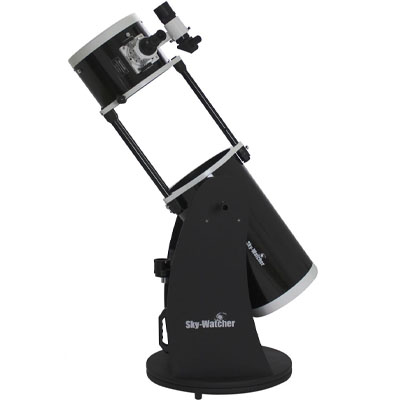
The next collapsible telescope for review is the fabulous Sky Watcher 10in. Flextube 250P Collapsible Dobsonian. You would think that a telescope with a huge 10 inch aperture would be difficult to take along on a stargazing trip. Not this one!
It has a unique design that allows the optical tube to collapse for ease of portability. The optical tube and the base separate into two sections. And, it keeps its collimation, so when you put it back together it is perfectly aligned. Weighing only 42 lbs when fully assembled, this 10″ Dobsonian easily packs into a car.
The telescope has a 1200mm focal length and offers crystal clear views. This is thanks to the Dobsonians mirrors, made with borosilicate glass, and coated with quartz, titanium, and silicon dioxide.
Get amazing views of the Moon’s craters, deep-sky objects, Saturn’s rings, and Jupiter’s moons. For ease of locating celestial objects, you will enjoy the tension control handles that give precise, smooth, and accurate movement.
The kit comes with a 2-inch Crayford-style focuser, and two super wide-angle eyepieces, a 25mm offering 48x power magnification, and a 10mm offering 120x power magnification.
You also get an 8X50 right-angle FinderScope for ease of locating objects. If you want value for money, this is one of the best priced collapsible telescopes on the market and will last for a lifetime.
What we liked
- 10″ aperture, 1200mm focal length
- Unique collapsible design
- Retains collimation when collapsed
- 2″ Crayford-style focuser
- 2 eyepieces, 25mm and 10mm
- 8X50 right-angle erect-image finderscope
- Tension control handles
What we didn’t like
- Higher price
- Some learning curve to get started
- Some users wanted a Barlow lens – not included
Aperture: 254 mm (10 in)
Focal Length: 1200mm
Motorized: No
Focuser: 2″ Crayford-style focuser with 1.25″ adaptor
Eyepieces: Plossl 25mm and 10mm
Weight: 42 lbs (19 kg)
Dimensions: 38 x 27 x 19 inches
3. Orion 8944 SkyQuest XT6 Classic Dobsonian Telescope
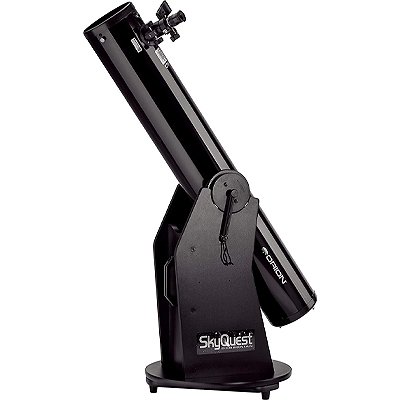
This is the best budget Dobsonian telescope, ideal for beginners.
If your family cannot get enough of the galaxy and you want a more advanced, but very cost-effective telescope, this is the model to choose.
The great feature of this scope is the large 150mm (6”) aperture coupled with a simple base that allows easy point-and-look navigation.
Set-up is very quick and there is no need to struggle with polar alignment. Even my younger children found it easy to use.
Included in the set is a 1.25” Rack-and-pinion focuser, an EZ Finder II aiming device, a 25mm (1.25″) Sirius Plossl eyepiece, and a quick-collimation cap.
We enjoyed looking at crisp images of the moon craters. We also saw amazing views of deep-sky nebulae, galaxies, and star clusters.
What we liked
- Very well priced
- Large 150mm (6”) aperture
- Easy point-and-view
- Assembly tools included
- Sturdy base, won’t topple
What we didn’t like
- A bit bulky
- Not easily transportable
Aperture: 150mm (6”)
Focal Length: 1200mm
Motorized: No
Focuser: 25mm (1.25”) rack-and-pinion focuser
Eyepieces: 25mm (1.25″) Sirius Plossl
Weight: 20.1 pounds
Dimensions: 48.7 x 16.3 x 13.6 inches
4. SkyWatcher S11620 Traditional Dobsonian 10-Inch Telescope
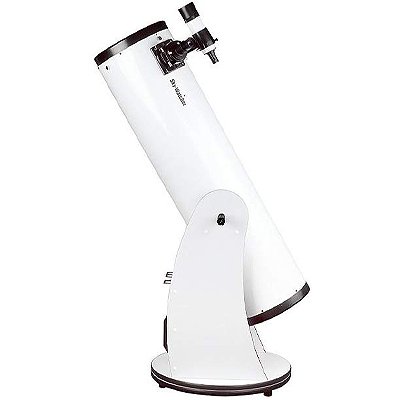
This 10” Dobsonian telescope offers the most aperture for your money. After being impressed by the Skywatcher 8” model, we decided to try out the bigger version.
It also comes in white and features the very handy tension control handle. This allows you to easily change the settings which it maintains when released.
The massive 254mm (10”) Newtonian-style aperture gave stunning views of the galaxy, deep-sky objects, planets, and stars.
Included in the set is a 2” single-speed Crayford-style Focuser with a 1.25” adaptor. It also comes with 2 eyepieces, a 1.25″ Super 25 mm and a 10mm.
This model is a step up from the smaller SkyWatcher 8” and makes a great buy for beginners who are becoming serious skywatchers.
What we liked
- Most aperture for your money
- Large 254mm (10”) aperture
- 2 eyepieces
- Solid rocker-mount
- Easy to use
What we didn’t like
- Heavier than others
- Not easily transportable
Aperture: 254mm (10”)
Focal Length: 1200mm
Motorized: No
Focuser: 2” single-speed Crayford-style Focuser with 1. 25” adapter
Eyepieces: 1.25″ Super 25 mm and 10 mm
Weight: 40 pounds
Dimensions: 49 x 27 x 20 inches
5. Sky Watcher 8in. Flextube 200P Collapsible Dobsonian Telescope

When we head out on a weekend away for stargazing, the family wants a telescope that is light and portable. Struggling to set up a heavy scope is not for us. This next review is for a fabulous collapsible Dobsonian telescope.
The design of this 8″ Dobsonian allows the optical tube to collapse for ease of portability. The optical tube and the base separate into two sections. And, it keeps its collimation, so when you put it back together it is perfectly aligned.
The telescope has a large 8-inch aperture and a 1200mm focal length. The mirrors are constructed with borosilicate glass and coated with quartz, titanium, and silicon dioxide. You will see crystal clear, bright images of the planets and deep-sky objects.
View Saturn’s rings and Jupiter’s moons. See the red planet Mars and craters on the Moon. For ease of finding celestial objects, it has tension control handles that allow for accurate movement.
This is a comprehensive kit that comes with a 2-inch Crayford-style focuser, and two super wide-angle eyepieces, a 25mm, and a 10mm. You also get an 8X50 right-angle finder scope for ease of locating objects. Weighing only 40 lbs when fully assembled, (24 lb tube, 26 lb base), it is ideal to pack into a car.
What we liked
- 8″ aperture, 1200mm focal length
- Unique collapsible design
- Retains collimation when collapsed
- 2″ Crayford-style focuser
- 2 eyepieces, 25mm and 10mm
- 8X50 right-angle erect-image finderscope
- Tension control handles
What we didn’t like
- Higher price
- Some learning curve to get started
- Some users struggled with collimation
Aperture: 203 mm (8-inch)
Focal Length: 1200mm
Motorized: No
Focuser: 2″ Crayford-style focuser with 1.25″ adaptor
Eyepieces: Plossl 25mm and 10mm
Weight: 40 lbs (18.1 kg)
Dimensions: 36 x 26 x 19 inches
6. Sky Watcher S11610 Traditional 8-Inch Dobsonian Telescope
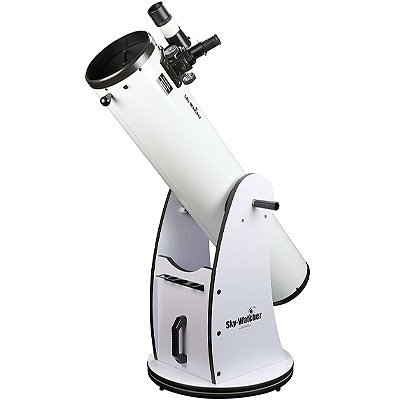
The SkyWatcher S11610 is a good choice for amateurs, priced in the middle range. It comes in a stylish white color, which attracted my eye.
The scope arrived in 2 boxes, one with the tube and one with the base. We managed to set it up fairly easily using the instruction manual.
The telescope features a 203mm (8”) Dobsonian-style Newtonian lens. The glass is Borosilicate, which is extremely strong and shatterproof.
The package includes two eyepieces, a Super 25mm and a Super 10mm 1.25”. It has a 9×50 finderscope and a 2” single-speed Crayford with 1.25” adapter.
This model has a tension control handle, which allowed us to move the mount easily. When released, the telescope kept its position and view of the skies. Using this scope, we saw great images of the Moon and some amazing views of Saturn’s rings.
What we liked
- Well priced in the middle range
- Large 203mm (8”) aperture
- 2 eyepieces
- Easy to use with a tension handle
- Good choice for amateurs
What we didn’t like
- Base adds an extra 20 pounds to the weight
- Not easily transportable
Aperture: 200mm (8”)
Focal Length: 1200 mm
Motorized: No
Focuser: 2” single-speed Crayford-style Focuser
Eyepieces: 25mm and 10mm 1.25”
Weight: 27.4 pounds
Dimensions: 49 x 27 x 18 inches
7. Zhumell Z12 Deluxe Reflector Dobsonian Telescope
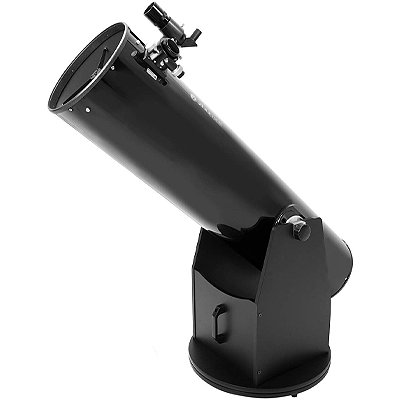
The final Dobsonian telescope that we reviewed was the Zhumell Z12. It is step up from the Z8 and comes at a higher price.
This model is better suited for more professional skywatchers, but we enjoyed it just as much.
It features a 305mm (12”) parabolic lens that captures large amounts of light and produces bright and clear images.
There are two eyepieces. The first is a 30mm (2”) eyepiece for wide-field views. The second is a 9mm (1. 25”) eyepiece for higher magnification.
This model offers precise focusing with a dual-speed Crayford focuser. It has an adjustable balancing and an included laser collimator.
We especially enjoyed the moon filter, which gave exquisite views. If you want to invest in a lifetime telescope, this is the model of choice.
What we liked
- Very large 305mm (12”) parabolic lens
- Clear, crisp views
- 2 eyepieces 30mm (2”) and 9mm (1.25”)
- Right Angle Finderscope
- Included laser collimator
What we didn’t like
- Higher pricepoint
- Not motorized
Aperture: 305mm (12”)
Focal Length: 1500mm
Motorized: No
Focuser: Dual speed Crayford focuser
Eyepieces: 30mm (2”) and 9mm (1. 25”)
Weight: 50.7 pounds
Dimensions: 26 x 26 x 64 inches
8. Zhumell Z8 Deluxe Reflector Dobsonian Telescope
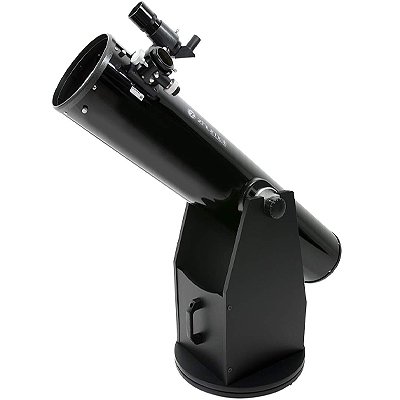
If you are looking for the best price/value ratio, this is the telescope to choose from.
It features a 200mm (8”) parabolic primary mirror lens that produces crisp, bright images.
It comes with two eyepieces. The first is a 30mm (2”) eyepiece for wide-field views.
The second is a 9mm (1.25”) eyepiece, which gives higher magnification. For ease of use, it has an included Laser Collimator, which we found very useful.
We found that the sturdy, durable construction made it fairly portable. It breaks down into two manageable pieces and we were able to take it along on a weekend away from the city lights.
The family enjoyed viewing the Moon with the moon filter. We also enjoyed views of planets, nebulae, and deep-sky objects.
What we liked
- Ideal first telescope
- Great price / value ratio
- Large 200mm (8”) aperture
- 2 eyepieces 30mm (2”) and 9mm (1.25”)
- Right Angle Finderscope
- Breaks into 2 pieces for easy transporting
What we didn’t like
- Somewhat higher price
Aperture: 200mm (8”)
Focal Length: 1200mm
Motorized: No
Focuser: Dual speed Crayford focuser
Eyepieces: 30mm (2”) and 9mm (1.25”)
Weight: 33 pounds
Dimensions: 19 x 19 x 51 inches
9. Orion SkyQuest XT6 PLUS Reflector Dobsonian Telescope
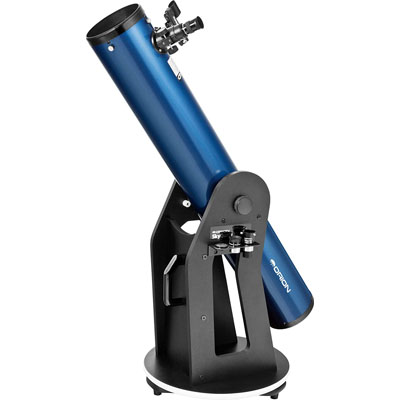
The New Orion SkyQuest XT6 PLUS Dobsonian Reflector Telescope is an upgraded XT6 Classic Dobsonian with additional accessories and design enhancements that boost the performance. Being a great fan of Dobsonian telescopes, the stylish eye-catching twilight blue optical tube is thrilling!
The telescope has a large 150mm (6-inch) aperture and a 1200mm focal length. It stands on a redesigned base that has adjustable altitude tension supports. Collimation is easy and requires no tools.
You simply use the knurled secondary mirror thumbscrews to make adjustments. The lightweight portable Dobsonian telescope comes with 2 Sirius Plossl eyepieces, a 25mm and a 10mm. It also includes a Shorty 2x Barlow that doubles the magnification of each eyepiece. In the kit is an eyepiece rack and collimation cap.
The EZ Finder II Red Dot reflex sight makes it easy to locate celestial objects by simply aiming your telescope at them. Get the family out at night and take a look at the Moon’s cratered surface, Jupiter’s cloud bands, or the Hercules Cluster’s dense core.
There is an added feature on this 6-inch Dobsonian telescope that is really useful. The base of the Dobsonian telescope mount has a bright white base trim. It helps avoid accidents in dark conditions. You won’t find yourself tripping over, or bumping into the telescope – a great plus!
What we liked
- Best budget Dobsonian telescope
- 150mm aperture, 1200mm focal length
- Altitude tension knobs
- 2 Sirius Plossl eyepieces, 25mm and 10mm
- Orion Shorty 2x Barlow
- Orion EZ Finder II Reflex Sight
- Collimation cap
- Dust cover for the optical tube
What we didn’t like
- Some users complained about the quality of the FinderScope
- Not computerized
Aperture: 150mm (6 inch)
Focal Length: 1200mm
Motorized: No
Focuser: 1.25″ Rack-and-pinion
Eyepieces: Sirius Plossl eyepieces, 25mm and 10mm
Weight: 34.2 lbs (15.5 kg)
Dimensions: 51 x 18 x 51 inches
10. Orion SkyQuest XT10i IntelliScope Dobsonian Telescope
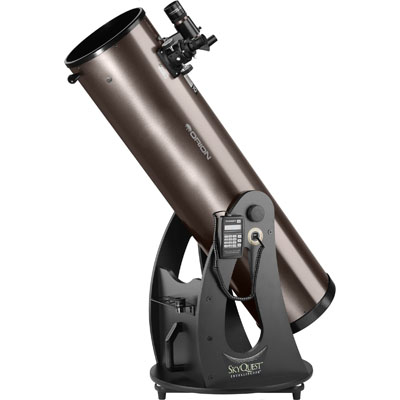
This large 10-inch Dobsonian has a higher price and is better suited to more advanced users. It features a push-to computerized IntelliScope Object Locator system that will guide you to over 14,000 celestial objects. The IntelliScope’s Object Locator can also take you on a tour of the best sights to see in any month of the year.
With this best Dobsonian telescope, you will get amazing views of deep-sky objects, star clusters, nebulas, far-away galaxies, and close-up views of the Moon’s craters, and planets. The large base has CorrecTension adjustment knobs that keep the telescope optical tube balanced in any viewing position.
It also ensures smooth manual tracking control for you to follow an object across the sky with this dob telescope. This telescope comes with 2 Sirius Plossl eyepieces, a 25mm with 48x power magnification, and a 10mm with 120x power magnification.
It Includes a 2″ Crayford focuser that allows ultra-smooth adjustment. and allows you to input the celestial details. The 9×50 right-angle correct-image finder helps you easily locate the object you want to view. For getting organized, there is an eyepiece rack to hold all your accessories.
Sometimes it is overwhelming to know where to start! The Starry Night software package guides you to what stars, constellations, planets, and other cosmic objects will be visible when you start stargazing. You can choose any day and any time, from wherever you are on the planet.
What we liked
- Large 254mm (10-inch) aperture
- 2 eyepieces, Sirius Plossl 25mm and 10mm
- SkyQuest IntelliScope System
- IntelliScope object locator hand controller
- Orion 9X50 finderscope
- Collimation cap
- Telescope eyepiece rack
What we didn’t like
- Higher price for this dobson telescope
- Large and heavy – not easily portable
- Some learning curve to get started
Aperture: 254mm (10 inch)
Focal Length: 1200mm
Motorized: No
Focuser: 2″ Crayford
Eyepieces: Sirius Plossl 25mm and 10mm
Weight: 55.3 lbs (25 kg)
Dimensions: 69.3 x 64.8 x 13.7 centimetres
Also read:
- 5 Best Star Projectors in 2020 [for Home Planetarium]
- 5 Best Travel Telescopes in 2020 [Portable & Durable]
- 5 Best Astronomy Observing Chairs in 2020 [Ergonomic & Comfortable]
Newtonian vs. Dobsonian telescope
In your search for a telescope, the common buzzwords you are likely to come across are Newtonian and Dobsonian. What are they and what is the difference?
Newtonian Telescopes
Sir Isaac Newton invented these telescopes in 1668. They are also known as reflecting telescopes. Before reflecting telescopes, we had refracting telescopes. This design uses lenses to collect light and focus it on a single point, which often gives blurred images.
Newton used mirrors in place of the lens. The mirrors reflect the light into eyepieces, giving a much clearer image. Newtonian telescopes do not travel well. They tend to lose their alignment and then require time-consuming realignment each time.
Dobsonian Telescopes
Named after Sir John Dobson in 1960. The stand-out feature of this telescope is the altazimuth mount. This is the main structural difference between Dobsonian and Newtonian telescope.
Dobsonian telescopes use thinner mirrors and the tubes are made of thick industrial compressed paper, rather than aluminum or fiberglass.
Large apertures at affordable costs. This is one of the prime considerations of the Dobsonian design. Dobsonians are designed with beginners in mind. The Dobsonian vision is to bring powerful telescopes to the amateur.
Dobsonian telescope is perfect for beginners
Newtonian and Dobsonian telescopes may sound similar, and, indeed, they do share common features. However, I would wholeheartedly recommend a Dobsonian as your first telescope. With a design specifically for beginners, they are easier to set-up, use, and understand.
Here are some of the key points
- More aperture for your money. Large apertures usually cost more. In the Dobsonian range, you will find 8” to 12” apertures (very big!) at extremely affordable prices.
- Simple designs. As a beginner, you don’t want to struggle to set-up your telescope. Dobsonians are easy and many are point-and-view, adding to the fun experience.
- Large light gathering capabilities and depth of sight. These scopes collect large amounts of light and focus it on a single point. This results in images that are super sharp, crisp, and clear.
- Altazimuth mounts. Easy to use mounts that move up and down, left and right. Perfect for beginners to work with.
- Far more portable. The best views of the night sky are usually found away from the lights and pollution of the city. Traveling with a telescope can be a challenge. Dobsonian telescopes are designed to disassemble the tube from the base. This makes it is easy to load into a vehicle and take along on an outing.
Dobsonian telescope price timeline
The Dobsonian telescopes for beginners that we reviewed range in price from around $250 to $900. Like most high-end gadgets, you will find cheaper and more expensive models. Buying cheap is not always a good option. But, sometimes, paying a premium may not give you value for money.
Here is a quick overview of what you can expect from the different price ranges.
$100 – $300 – This cheaper range also includes a few tabletop models, which are great for traveling and easy set-up. This range usually comes with one eyepiece. They are ideal for younger and beginner stargazers. They also make great gifts.
$300 – $500 – Dobsonian scopes in this range offer large 8” lenses, which give fabulous crisp, clear views. They provide exceptional price/value ratio. Most come with two eyepieces. At this price point, you won’t get tracking.
$500 – $700 – Spending more, you will get the benefit of larger lenses up to 10”. The focal length is also longer, offering clearer and deeper views of celestial objects.
$700 – $1000 – This range offers instruments for professionals and serious amateurs. They offer 12” parabolic mirrors and a range of additional optical accessories.
$1000 Plus – At $1000+, you are entering the professional league. These scopes offer both computerized GoTo Options and manual tracking. Unique Truss-Tube designs allow disassembly for moving to observation sites around the country.
What can you see with a Dobsonian telescope?
When we first bought a telescope, the kids were super excited to see the Moon. But, we soon realized that there is a huge world of fascinating objects out there that could be easily viewed.
Dobsonian telescopes have a wide field of view, to give the best images of the wonderful world of celestial objects. They have large lenses that gather light and give crisp images that are not distorted. The Altazimuth mount makes it easy to set-up and point the scope to focus on any object you choose.
We soon learned about Near Space Objects. These include the Moon, the Planets, and the Sun. The special Moon Filter that comes with some models will reduce glare and bring out more contrasting surface detail. After the Moon, we focused on Saturn. Seeing the rings sends shivers down your spine! We also saw Mars’ two satellites.
We soon got more ambitious and progressed to Deep Space Objects, known as DSOS. These include Galaxies, Nebulae, and Star Clusters. With the help of Star Guides that come with the telescopes, we were able to pinpoint constellations and learn about their fascinating ancient mythological stories.
How to choose the right Dobsonian telescope?
Here are some key points to consider when choosing the best Dobsonian telescope.
Aperture
For great views, choose a telescope with an aperture of 8” or more. Dobsonians offer this large range at affordable prices. With this size, you will get clear views of Moon craters and deep sky objects.
Focal length
The longer the focal length, the better. Look for 1200 to 1500mm as a starting point.
Mount
Most Dobsonian telescopes come with Altazimuth mounts. These are lightweight, easy to set-up, and use. They move up and down, left and right. Telescopes with tabletop mounts are great for traveling.
Portability
If you plan on taking your stargazing out of the city, you will certainly get the benefit of clearer, less polluted skies. Your scope needs to be lightweight and compact. Scopes that can be disassembled are best. If they don’t come with a carry bag, invest in a sturdy padded bag that protects your instrument while in transit.
Ease of set-up
Spending hours aligning your telescope is not something you want to do. Point-and-view models are simple and get you stargazing in no time.
Extra Accessories
Extra accessories add value to your viewing experience. Different size lenses give different magnifications. Moon filters enhance the view. Finderscopes make it easy to locate your objects.
FAQ
Is a Dobsonian telescope good?
Yes, a Dobsonian telescope is very good. They are ideal for all skill levels from beginners to advanced stargazers. They offer great value for money, with larger apertures and crystal-clear images.
What is the difference between a Newtonian and Dobsonian telescope?
Dobsonian telescopes use thinner mirrors and generally offer larger apertures than Newtonian models. Newtonian telescopes are mostly bulkier than Dobsonian telescopes. The main difference is the Dobsonian mount. Dobsonian telescopes have special altazimuth mounts.
What is the best Dobsonian telescope?
A best Dobsonian telescope is the Orion SkyQuest XT8 Classic Dobsonian Reflector Telescope Kit. It comes with a 28mm DeepView eyepiece and a 10mm Sirius Plossl eyepiece. Also included is a Shorty 2x Barlow.
What is the best 6 inch Dobsonian telescope?
If you want a large aperture in a cheap Dobsonian telescope, the best 6″ Dobsonian is the Orion SkyQuest XT6 PLUS Dobsonian Reflector Telescope. It is perfect for a family wanting to start stargazing as a hobby.
What is the best 8 inch Dobsonian telescope?
The Sky Watcher 8in. Flextube 200P Collapsible Dobsonian Telescope 200 is an amazing 8 inch Dobsonian telescope with a collapsible design. It is ideal to take along on a weekend trip.
What is the best 10 inch Dobsonian telescope?
Offering a massive 10 inch aperture, The Sky Watcher 10in. Flextube 250P Collapsible Dobsonian Telescope is great value for money. It has high quality optics for stunning views of celestial objects.
What is the best 12 inch Dobsonian telescope?
The Skyline 12″ Dobsonian telescope offers great features and deluxe accessories. It comes with a precision 2″ Crayford focuser that features dual-speed adjustment control. This 12 inch Dobsonian will give a lifetime of stargazing.
What is the best 14 inch Dobsonian telescope?
The Sky-Watcher 14″ Flextube SynScan GoTo Collapsible Dobsonian is ideal for advanced home astronomers. It offers the convenience, portability, and affordability of a traditional Dobsonian with the added perk of a computerized Go-To telescope.
How does a Dobsonian telescope work?
The optics of Dobsonian telescopes work in the same way as Newtonian telescopes. They have a concave spherical or parabolic primary mirror at the back of the telescope. This mirror collects and focuses the incoming light onto a flat secondary mirror. The secondary mirror then reflects the image into the eyepiece.
Can you take pictures with a Dobsonian telescope?
Yes, you can take pictures with a Dobsonian telescope. Ensure that the model you buy has a connection to attach a Digicam or a DSLR (Digital single-lens reflex) camera.

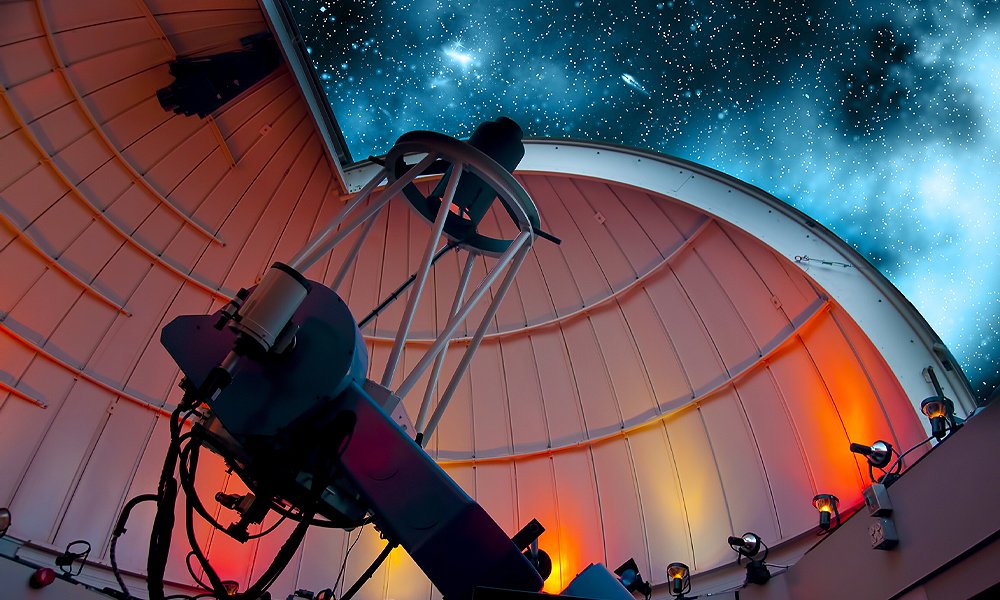
![12 Best Refractor Telescopes Actually Worth the Money [2024]](https://www.planetguide.net/wp-content/uploads/2019/12/refreactor-telescope-768x461.jpg)
![10 Best Telescopes Under 0 [in 2024]](https://www.planetguide.net/wp-content/uploads/2020/06/Depositphotos_273495332_s-2019-768x499.jpg)
